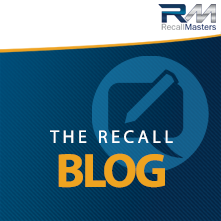Recall Quandary: Who is to Blame?
Recall Quandary: Who is to Blame?
A Blog Post by Sean Reyes, Chief Marketing Officer for Recall Masters
Automotive News recently reported that a Ford dealership in Texas, and Ford Motor Co., are facing a lawsuit by a woman who incurred severe injuries during a collision when the passenger-side airbag deployed and expelled shrapnel resulting in the loss of her left eye. She is now suing the OEM and dealership.
She has been advised by legal counsel that it is Ford’s responsibility to put safe vehicles on the road and, believe it or not, the vehicle was recently in the dealership to get the Takata airbag (an almost 10-year-old recall) repaired. However, they only replaced the driver’s side airbag, not the passenger’s side. That mistake proved costly to the passenger and, ultimately, weakens the legal defense for the dealership.
There have been many injuries and deaths (19 deaths and four hundred injuries) involving Takata airbags in the last decade and this is the largest recall in automotive history. Takata itself filed for bankruptcy and was acquired, but the lingering impact persists. Manufacturers still need airbags to build and distribute vehicles to dealerships. A different supplier may appear and offer more reliable airbags but, for now, manufacturers need to continue production and dealers still need vehicles to sell.
According to the article, the finger-pointing is heating up. In an official response to Automotive News, a Ford spokesperson, Catherine Hargett, stated “In this instance, Ford went to substantial lengths to have the inflator repaired, sending over 30 recall notices (before and after the failed repair) to the registered owner and even sending a mobile repair unit to the owner’s home and knocking on the door.”
For the moment, there are plenty of unanswered questions in this case. Was the injured party the owner of the vehicle? If not, it is very possible she was not included in Ford’s efforts to notify the owner. It is reported that they attempted to notify the registered owner multiple times. If the dealership itself (which did not respond to Automotive News’ questions) did attempt to notify the registered owner, was it the registered owner who brought the vehicle in to the dealership? For example, if a child or friend of the registered owner is the primary driver, and the person that takes the vehicle into the dealership for service, would the dealership attempt to contact this driver, while Ford attempts to contact the actual registered owner?
There are a lot of variables here and we will not have the answers to these questions anytime soon. This does, however, illustrate the complexities of contacting primary drivers and those bringing the vehicle in for service. It is imperative that the correct person is notified and that all safety recall repairs are completed. It is no mystery – recapturing out-of-warranty vehicles into the dealership is extremely difficult, even with a dangerous recall at hand. Consumers, for the most part, intend to take care of recalls, but are confused about the process and are not necessarily thrilled with investing the time to address a vehicle repair. As an industry, we need to continue to streamline our processes and do a better job of winning back these lost customers by rolling out the red carpet. Perhaps the service experience has improved since the last time the owner was in the dealership. Owners often assume that there are costs involved or that they will lose the use of their vehicle for days. Lastly, when vehicles are in the service lane, it is imperative that we catch every recall, every time. There is a lot at stake, and you can’t afford to be wrong or careless.
While the dealership has yet to respond, the bottom line is that this situation has three parties that the plaintiff is blaming – Ford, the dealership, and the owner of the vehicle that collided with their vehicle. Regardless of the outcome, one of the three will be held responsible. And that is sad considering that someone, whoever that is, did bring the vehicle in for a recall repair which was not fully completed (for whatever reason) and it ended up in a tragedy. In all likelihood, a jury will never hear this case. OEMs are on the hook for manufacturing defects regardless of ensuing recalls and attempts to notify the owner or dealerships that do not perform the necessary repairs. This case will settle out of court and both Ford and the dealership are going to pay. The question I have is how Ford will handle the situation with the dealer.
About the Author


